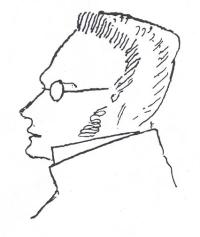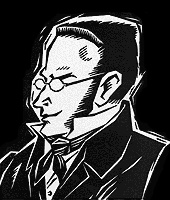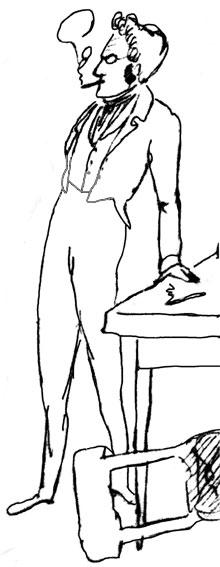<Back to Index>
- Philosopher Johann Kaspar Schmidt (Max Stirner), 1806
- Painter Pablo Ruiz Picasso, 1881
- Prime Minister of the United Kingdom William Wyndham Grenville, 1759
PAGE SPONSOR



Johann Kaspar Schmidt (October 25, 1806 – June 26, 1856), better known as Max Stirner (the nom de plume he adopted from a schoolyard nickname he had acquired as a child because of his high brow, in German 'Stirn'), was a German philosopher, who ranks as one of the literary fathers of nihilism, existentialism, post-modernism and anarchism, especially of individualist anarchism. Stirner's main work is The Ego and Its Own, also known as The Ego and His Own (Der Einzige und sein Eigentum in German, which translates literally as The Only One and his Property). This work was first published in 1844 in Leipzig, and has since appeared in numerous editions and translations.
Stirner was born in Bayreuth, Bavaria. What little is known of his life is mostly due to the Scottish born German writer John Henry Mackay, who wrote a biography of Stirner (Max Stirner - sein Leben und sein Werk), published in German in 1898 (enlarged 1910, 1914), and translated into English in 2005. Stirner was the only child of Albert Christian Heinrich Schmidt (1769 – 1807) and Sophia Elenora Reinlein (1778 – 1839). His father died of tuberculosis on April 19, 1807 at the age of 37. In 1809 his mother remarried to Heinrich Ballerstedt, a pharmacist, and settled in West Prussian Kulm (now Chełmno, Poland).
When Stirner turned 20, he attended the University of Berlin, where he studied Philology, Philosophy and Theology. He attended the lectures of Georg Wilhelm Friedrich Hegel, who was to become a source of inspiration for his thinking. While in Berlin in 1841, Stirner participated in discussions with a group of young philosophers called "Die Freien" ("The Free"), and whom historians have subsequently categorized as the Young Hegelians. Some of the best known names in 19th century literature and philosophy were members of this discussion group, including Bruno Bauer, Karl Marx, Friedrich Engels, Ludwig Feuerbach, and Arnold Ruge. While some of the Young Hegelians were eager subscribers to Hegel's dialectical method, and attempted to apply dialectical approaches to Hegel's conclusions, the left wing members of the group broke with Hegel. Feuerbach and Bauer led this charge.
Frequently the debates would take place at Hippel's, a wine bar in Friedrichstraße, attended by, among others, the young Karl Marx and Friedrich Engels,
at that time still adherents of Feuerbach. Stirner met Engels many
times and Engels even recalled that they were "great friends", but
it is still unclear whether Marx and Stirner ever met. It does not
appear that Stirner contributed much to the discussions but was a
faithful member of the club and an attentive listener. The
most often reproduced portrait of Stirner is a cartoon by Engels, drawn
40 years later from memory on the request of Stirner's biographer, John Henry Mackay. Stirner worked as a schoolteacher in a gymnasium for young girls owned by Madame Gropius when he wrote his major work, The Ego and Its Own, which in part is a polemic against the leading Young Hegelians Ludwig Feuerbach and Bruno Bauer, but also against communists such as Wilhelm Weitling and the anarchist Pierre-Joseph Proudhon.
He resigned from his teaching position in anticipation of the
controversy arising from his major work's publication in October 1844. Stirner
married twice; his first wife was a household servant, with whom he
fell in love at an early age. Soon after their marriage, she died due
to complications with pregnancy in 1838. In 1843 he married Marie Dähnhardt, an intellectual associated with Die Freien. They divorced in 1846. The Ego and Its Own was dedicated "to my sweetheart Marie Dähnhardt". Marie later converted to Catholicism and
died in 1902 in London. Stirner planned and financed (with Marie's
inheritance) an attempt by some Young Hegelians to own and operate a
milk-shop on co-operative principles. This enterprise failed partly
because the dairy farmers were suspicious of these well dressed
intellectuals. The milk shop was also so well decorated that most of
the potential customers felt too poorly dressed to buy their milk there. After The Ego and Its Own, Stirner wrote Stirner's Critics and translated Adam Smith's The Wealth of Nations and Jean-Baptiste Say's Traite d'Economie Politique into German, to little financial gain. He also wrote a compilation of texts titled History of Reaction in
1852. Stirner died in 1856 in Berlin from an infected insect bite; it
is said that Bruno Bauer was the only Young Hegelian present at his
funeral, which was held at the Friedhof II der Sophiengemeinde Berlin. Stirner's claim that the state is an illegitimate institution has made him an influence upon the anarchist tradition; his thought is often seen as a form of individualist anarchism.
Stirner however does not identify himself as an anarchist, and includes
anarchists among the parties subject to his criticism. Stirner mocks revolution in the traditional sense as tacitly statist. David Leopold's conclusion (in his introduction to the Cambridge University Press edition)
is that Stirner "...saw humankind as 'fretted in dark superstition' but
denied that he sought their enlightenment and welfare". As with the Classical Skeptics,
Stirner's method of self liberation is opposed to faith or belief; he
believed that life is free from "dogmatic presuppositions" or any "fixed standpoint". It is not merely Christian dogma but also a variety of European atheist ideologies that he condemned as crypto Christian for putting ideas in an equivalent role. What
Stirner proposes is not that concepts should rule people, but that
people should rule concepts. The denial of absolute truth is rooted in
Stirner's the "nothingness" of the self. Stirner presents a detached
life of non-dogmatic, open-minded engagement with the world "as it is"
(unpolluted by "faith", Christian or humanist), coupled with the awareness that there is no soul, no personal essence of any kind. Scholars such as Karl Löwith and Lawrence Stepelevich have argued that Hegel was a major influence on The Ego and Its Own. Stepelevich argues that while The Ego and its Own evidently
has an "un-Hegelian structure and tone to the work as a whole", as well
as being fundamentally hostile to Hegel's conclusions about the self
and the world, this does not mean that Hegel had no effect on Stirner. To
go beyond and against Hegel in true dialectical fashion is in some way
continuing Hegel's project, and Stepelevich argues that this effort of
Stirner's is, in fact, a completion of Hegel's project. Stepelevich concludes his argument referring to Jean Hyppolite, who in summing up the intention of Hegel's Phenomenology, stated: "The history of the world is finished; all that is needed is for the specific individual to rediscover it in himself."